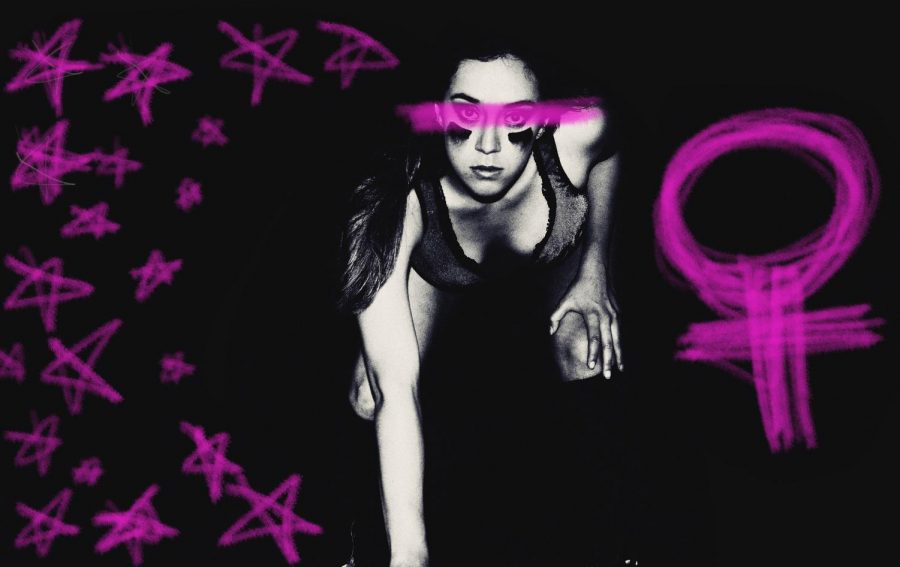Social justice needs a diversity of tactics
Students, activists should utilize past movements like Riot Grrrl in addition to rallies and social media
COURTESY OF UNSPLASH | EDITS BY HANAH GOETZ
The Riot Grrrl movement mixes punk rock aesthetics with an intersectional approach to gender, femininity and social change.
March 28, 2018
I fail at rallies. I am also a feminist, which makes this issue rather difficult.
I’m not good at standing there and screaming, despite being able to do that at a football game. I feel silly. I feel like I’m not being heard like I should. I am an introvert — I have a bubble that no one should touch unless invited. No, rallies are not for me.
I think the most jarring thing about them is that they are a pain to organize, and they manifest as a momentary discomfort. But what other outlets are there? I could share my political views on my Facebook, but I’m not on Facebook anymore because I’m sick of people sharing their political views. I’m sure I’m not the only one.
There needs to be more diversity in how we seek change. This can and should include social media and rallies, but there should be options for all kinds of personality types. We should consider learning from previous movements like Riot Grrrl.
A cultural phenomenon that started in the ’90s, Riot Grrrl is often considered the beginning of third-wave feminism which focused on the diversity of gender, sexuality, race and choices of femininity. It pulsed with the beat of punk music — girls and those outside the gender binary screaming their hearts out and bleeding their demands into everything they did.
These individuals created a movement of the underground DIY. They started their own zines, made music and took a man’s world and turned it into their own.
This type of movement can offer things that rallies and social media can’t, and vice versa.
Many of us don’t even register what’s on the screens before us anymore — yet we still skate by with this idea that sharing something is enough. It’s a part of it, but not the defining impact.
Kayley Delong is a social media and outreach specialist for the Women’s Resource Center on campus. She said that while social media can be a powerful tool for creating strong grassroots movements, it still allows information to be lost or misconstrued.
“The caveat of social media is that the reproduction of ideas and movements happens with or without the connection back to its base,” Delong said. “They can take things and reshape them to fit their narrative.”
Social media is useful, as it brings awareness to a lot of injustices that we probably wouldn’t hear of otherwise. Delong points out that social media has been a crucial tool for the Black Lives Matter movement.
Rallies are similarly useful — they’re punchy and fire people up, but they’re momentary. We need a continuous movement like Riot Grrrl to keep the fire alive.
The movement was physical — it was purely action. The punk-grunge scene, once only for men, began to see women taking the stage.
Yet, this movement faded.
The bands were the forerunners and bands break up. Media misconceptions hurt the image further, as they do with many movements today.
But there’s a lesson in this. One of the scene’s major impacts was the physicality of the movement — it was driven by zines, music and art, all shared in person. There was no struggle to gather people for a rally — the concerts were the rallies. Signs were replaced by inclusive spaces. From concerts to poetry, everyone interacts with art in some way.
While students on campus continue to push for more inclusive spaces and for administration to take action against discrimination on campus, emulating parts of the Riot Grrrl movement could help foster that change.
“For feminism to continue,” Delong said, “we have to remove ourselves from a sense of ego or ownership and recognize the people who came before us and will come after us.”
We don’t need to revert back to a purely physical movement, but we can integrate it with our current resources. Yes, social media plays a big role, we just can’t completely rely on it. Many people believe that sharing on Facebook is enough to make an impact, and that they don’t ever have to take part in physical action.
That action is what we need more of, and we need to make it almost unconscious and natural for it to really get support.










